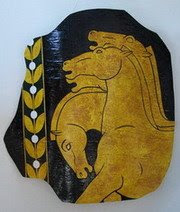 ONE day a SMS came and it was from Entang Wiharso, an Indonesian leading artist who is now living in Rhode Island, USA, with his wife and two sons. He was invited as an artist-in-residence at Amherst College for six months, last year. He spent his vacation in Indonesia, for around one month, and delivered a speech in a one day seminar at Jogja Biennale IX, last November.
ONE day a SMS came and it was from Entang Wiharso, an Indonesian leading artist who is now living in Rhode Island, USA, with his wife and two sons. He was invited as an artist-in-residence at Amherst College for six months, last year. He spent his vacation in Indonesia, for around one month, and delivered a speech in a one day seminar at Jogja Biennale IX, last November.His SMS said that he invited some friends to have a farewell dinner before he is flying to see his family in USA. Well, it should be noted as an honor to me. Then I went to Jogja and join with some friends in a clear night in a restaurant near the artist’s house.
It took almost four hours to go there from Semarang, my hometown. Karbon, a student of Fine Art Department of Semarang State University, accompanied and drived for me. This young guy is good in photography. Some of his shots were used as poster and catalogue cover for Entang’s last solo exhibition “Intoxic” at Rumah Seni Yaitu. And ofcourse Karbon is extremely pleased.
The day was Saturday, February 9th, and I met many interesting people. There were three young Jogja based curators – Sudjud Dartanto, Kuss Indarto, and Wahyudin – whom were my counterparts when I took discussions at Cemeti Art Foundation for more than three months in the year 2004. The foundation now changed into Indonesia Visual Art Archive (IVAA).
 You know, Agung “Leak” Kurniawan, artist and the Director of the Foundation, once said that such discussion was a real “liar school”. He meant that because the discussions had no certain modules or any fixed programmes. They were held at night twice a week and some scholars gave their papers to the limited attendants. I was very lucky to join it. The school enlarged my mind on theories of contemporary visual arts. But I had to drive to Jogja in the morning then went home late at night. I often arrived home at dawn the next day for some discussions ended rather late. There were all hard days and cost very expensive, but I sincerely wish thank to the good friends of the Foundation.
You know, Agung “Leak” Kurniawan, artist and the Director of the Foundation, once said that such discussion was a real “liar school”. He meant that because the discussions had no certain modules or any fixed programmes. They were held at night twice a week and some scholars gave their papers to the limited attendants. I was very lucky to join it. The school enlarged my mind on theories of contemporary visual arts. But I had to drive to Jogja in the morning then went home late at night. I often arrived home at dawn the next day for some discussions ended rather late. There were all hard days and cost very expensive, but I sincerely wish thank to the good friends of the Foundation.There were some young artists, friends, and also Entang’s relatives joined the dinner. We talked and laughed all night. But in the middle we also had some serious deal, meant: we blew rumors on todays arts booming – especially paintings – and the artists’ behaviors concerning the terrible art market. Well, well, well…, no any painters are broke nowadays in Jogja. But elsewhere? Who knows.
Then we walked down to the artist’ house. I noted that Entang was exploring a new medium – paper – for his newest works. He pressed the paper in such a way so that there are hollowed images on it. As usual, his images are very strange and intriguing. The most excited news is: the artist gave me two papers! Olala....
[Hendro Wasito, a truly art lover lives at Semarang, brought the art-works to me several days after the dinner party. He did not join the dinner but visited the artist at another day. I wish my deeply thank to the gentleman.]
Karbon and I reached home at three at dawn. I insisted to go home because my son would have to take a test entering high school at ten o’clock at Sunday. What a hard day!***



+of+DSC07478.jpg)







+of+DSC05301.jpg)




